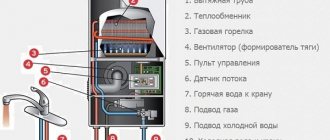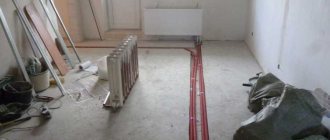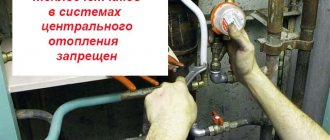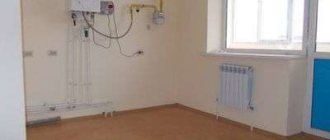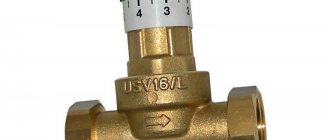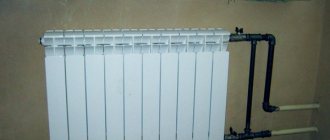The passage of a heating main with hot water near the place of residence is the prerogative of urban residents of apartment buildings; in country cottage villages, rural areas and dachas, the presence of a heating main laid nearby is very rare. An autonomous heating system helps solve the problem of heating a home in the cold season, which homeowners install in their home with the help of specialists from numerous companies or use the services of private craftsmen - doing the work yourself is problematic due to its high complexity and the need to use special plumbing tools.
Typically, individual houses are heated with heated water; due to its high heat capacity, it is the main type of coolant in heating systems; if it is necessary to take measures to protect against freezing of pipes, special non-freezing liquids (ethylene glycol, propylene glycol) are used in the system. Heating of liquid coolants is carried out using heating boilers operating on various types of fuel. The main task of the owner when choosing a heating method is to select the optimal type of fuel and boiler from the point of view of ease of use, minimizing costs during installation and operation, reliability and durability of the system.
Rice. 1 Autonomous heating system and example of boiler connection
It may be useful to read about Connecting the boiler to the heating system
Pros and cons of autonomous heating
Autonomous heating primarily means independence from various factors, natural conditions and organizations that are, to one degree or another, associated with the sale of heating services or heating materials in a given area. The advantages of individual heating are:
- Selecting heating equipment and fuel type that is suitable for your financial capabilities and ease of use.
- Possibility to set the start and end of the heating season at your discretion.
- Adjusting a comfortable temperature not only throughout the house, but also in individual rooms.
- When designing, the advantage is that it is possible to place heating radiators at your discretion, remove or install one or more than one section on them to optimize heat transfer. You can lay heated floors, choose the boiler power and the parameters of the entire heating system within a wide range, regardless of the characteristics of the external heating main, the official connection to which is subject to some restrictions.
- If you are away from the house for a long time, you can completely turn off the heating or set it to operate in economy mode.
- The use of double-circuit systems in an individual home allows not only to heat buildings, but also to heat cold water to a high temperature for use in everyday life and for personal hygiene purposes.
Rice. 2 Autonomous heating system in a private house - a variant of the heating and hot water supply scheme for DHW
- The use of solid or liquid fuels, which are stored in certain quantities, makes the heating system completely independent of external communications - gas pipelines, heating mains, and allows you to heat the house without being tied to emergency situations on engineering routes outside it.
Despite its many advantages, autonomous heating has quite significant disadvantages, the main ones being:
- Operation, maintenance and monitoring of an autonomous heating system takes up a lot of free time and requires some physical effort when using solid fuels.
- The main disadvantage of individual heating is the high cost of purchasing and installing equipment: a boiler, heat exchange radiators, manifold junctions and piping systems for underfloor heating, circulation electric pumps, plumbing fittings (air vents, check valves, shut-off valves and ball valves), automatic control.
- After installing the system, fuel costs also take up a significant part of the budget; many homeowners cannot afford to pay for the energy consumption of an electric boiler.
- During installation, additional costs will result in changing the configuration of walls, partitions and floors for laying pipelines, and installing screeds for heated floors.
- When using natural gas from the central pipeline as fuel, permission from the relevant services is required, and obtaining it is a long-term, complex and tedious procedure that requires the investment of significant sums of money.
- Financial resources will also be needed to ensure contractual obligations with organizations involved in the maintenance and repair of installed equipment and service center specialists.
Rice. 3 Operating principle of a closed heating system
Advantages and disadvantages of autonomous heating
In order for any autonomous heating to function normally and safely, its installation must be carried out by a professional.
Each such system has both its pros and cons. Therefore, when choosing this or that type of heating, you should focus on its advantages and disadvantages for a particular situation. So, the positives:
- Almost complete independence, that is, you yourself start the heating season, any time you want. And if you need to go somewhere, then the heating can be left at a minimum. However, it is impossible to turn it off completely during the cold season, as this will lead to cooling of neighbors’ apartments.
- Possibility of adjustment. At any time you can set the temperature that suits you.
- In addition, special thermostats can be installed on all radiators to control temperature and save energy.
- The opportunity to immediately provide yourself with hot water supply - if you purchase a double-circuit boiler.
And now a few words about the shortcomings. And the first thing that comes to mind is dismantling and installation. After all, during the remodeling, you will have to purchase new equipment, and almost all the old equipment will have to be dismantled. Moreover, during this work it will be necessary to even partially destroy the floors and interior partitions, and then restore everything and make cosmetic repairs.
The second important point is that if technically complex equipment is purchased and installed, you will have to enlist the support of special service departments for its periodic maintenance. But an even more significant disadvantage is obtaining various permits from the relevant departments. For which you will need to spend a lot of time and money.
Autonomous heating system - operating principle and main components
Any autonomous heating system includes the following main components:
Heat generator. It is a device that converts electrical or energy from burning fuel into heat, while the heat generator simultaneously transfers thermal energy to the coolant. Two main forms of the environment are used as a thermal carrier - air masses and liquid. Most often, purified distilled water is used in heating systems, which has the highest heat capacity coefficient, that is, the ability to transfer and accumulate energy; all other liquids, including non-freezing antifreeze, are significantly inferior to water in this indicator.
To convert fuel into thermal energy and transfer it to the carrier, the process of combustion occurs in heating boilers; if electricity is used, the heating of the coolant medium is carried out by heating the material with high electrical resistance to alternating current and its mutual heat exchange with the working fluid.
Heat conduction line. The coolant heated in the boiler is supplied to the heat exchange devices through pipes. Previously, steel pipelines were widely used (less often copper due to high cost), with the development of the chemical industry, steel is gradually being replaced by pipes made of polymers: PPR polypropylene, cross-linked polyethylene and PEX metal plastic.
Polymer pipes, due to their flexibility and elasticity, made it possible to install multi-circuit heated floors with water heating in buildings, which was impossible to do with metal pipelines.
Heat exchange devices. The coolant from the boiler flows through pipes into heat exchange devices, which in most cases are radiators; the liquid passes through them and transfers heat to the air due to the large area of the heat exchanger body. To increase or decrease thermal output, it is possible to change the battery configuration by adding or removing individual sections; the radiators are made of steel or aluminum, which have good heat output (high thermal conductivity).
Rice. 4 Air convector - operating principle
Autonomous heating system with air convectors
An autonomous air heating system usually involves the use of electric convectors, the built-in fan of which supplies air to the heating elements, after which it enters the room. Air conditioners operating in heating mode, and ordinary cheap electric heaters without fans with an open spiral, or oil heaters, where the heating element is immersed in the coolant, can heat the air. The latest technology is the use of energy-saving air-to-air heat pumps for heating; the thermal energy obtained as a result of their operation is transferred to the air masses and distributed throughout the entire area of the room due to built-in fans.
Heating rooms with heated air is not a very popular method among consumers and has the following features:
- All air heating options allow you to heat a room in a short time, unlike water heating, which requires significant time intervals to start supplying heat.
- Electric convectors with an open spiral burn oxygen - this worsens indoor air quality and can cause headaches.
- If one convector is used to heat several rooms, you will have to install a bulky air duct system and suspend it from the ceiling.
Rice. 5 Heating with air conditioners
- In addition to heating, a high-tech heat generator (air conditioner) is capable of performing the functions of humidifying, filtering or cooling air during the warm season.
- The heating installation and ventilation ducts are not at risk of defrosting during the cold season, as well as leakage of the coolant in the system, which is air.
- Air heating is easy to implement in any room of large or small area; in the simplest case, it is enough to connect the convector to an outlet to receive heat.
In addition to small heat generators running on electricity, stationary large heat generators running on gas or liquid fuel are used for air heating; their main components are (Fig. 7):
- Gas burner placed in a large volume container (housing).
- Combustion chamber in which gas combustion occurs and its thermal energy is transferred to the air.
- A system of fans providing air exchange and supply of heated air into the air ducts.
- Air duct hoses that direct the flow to different rooms.
- Electronic automatic control and monitoring system with setting the operating mode and temperature parameters of the convector.
Rice. 6 Autonomous heating system with heat pumps
Solid fuel heating
For many years, heating using solid fuels: coal, wood or biomass . Their prices vary and depend primarily on the amount of heat generated during combustion. Accordingly, the more you get, the lower the cost of purchasing fuel will be.
Environmentally friendly, selected coal remains very popular. You usually have to pay a little more for it than a regular one, but for many it is the most convenient heating method. For coal combustion, boilers with storage tanks that automatically supply fuel are provided. Their maintenance is less labor-intensive, unlike boilers, the fuel of which must be prepared manually. Once loaded, the charcoal needs to be replenished every few days.
Types of liquid autonomous heating systems
Heating systems for heating an individual home using water and non-freezing liquids (antifreeze) as a coolant differ in a number of ways, the main differences:
By type of fuel used . The most popular types of energy for heating coolants are electricity, gas, liquid flammable hydrocarbon mixtures (diesel fuel, fuel oil, oil, kerosene), a large number of solid combustible materials - firewood, coal, peat briquettes and pellets of various compositions. Electricity can be obtained either from energy companies or independently using solar panels, wind or hydraulic generators.
By type of thermal generators .
In modern heating systems, heating boilers are used to transfer energy to the coolant, which have design features and differences between analogues for each type of fuel. With a lack of funds, many craftsmen assemble autonomous heating with their own hands, using self-assembled structures, mainly solid fuel, instead of factory boilers, a typical example is a metal stove in a living room with an expansion tank in the attic and a steel piping system with radiators.
Which is better to choose?
A cost-effective solution for a private home would be gas heating. If there is no access to it, then you should pay attention to solid fuel. The system itself should be built according to a single-pipe scheme with a liquid coolant. By making this choice, you can save a lot on pipe laying and at the same time maintain the ability to control the temperature in each room.
If you want to install heating without pipes and radiators, then a stove made of metal or brickwork is perfect for this.
Boilers for water autonomous heating - types and features
Heating boilers are the most used equipment in the private sector, with their help they not only heat houses, but also heat cold water for household needs and personal use for hygiene purposes, using double-circuit modifications. Factory-made boilers are distinguished by their reliability and long service life, relatively affordable price, efficiency and comfortable operation; when installing simple collectorless heating systems with radiators only, it is possible to install all the heating equipment yourself. When choosing a boiler, they are primarily based on the cost and availability of fuel; their main options are discussed below.
Autonomous heating with gas boilers
Today, gas autonomous heating is the undisputed leader in prevalence due to the low cost of gas and a developed network of gas pipelines.
Gas heating has the following features:
- Lowest fuel costs compared to other types of fuel boilers.
- The cost of a typical boiler is higher than that of similar equipment of other types; its average price is about 42,000 rubles.
- The equipment requires regular maintenance by service specialists; before its installation, numerous approvals must be made with gas services.
- The gas is explosive, therefore, during installation and operation, special attention should be paid to the reliability and tightness of connections.
- When gas burns, oxygen is consumed, so good ventilation must be provided where the boiler is located. The product of combustion is soot, which settles on the inner walls of the chimney - this requires the use of measures to periodically clean it.
Rice. 10 Gas boiler - main components
Autonomous solid fuel heating system
Solid fuel boilers are classics and rank first in popularity in areas where there is no centralized gas supply; solid fuel heating has the following features:
- The cost of boilers is the lowest among all analogs; the average price of a standard model is about 17,500 rubles.
- Fuel is available in all areas of the country; in coal mining areas, coal is naturally used more often than other varieties; in the middle zone, peat briquettes, eurobriquettes, firewood and wood waste, and pellets are popular.
- Storage of solid fuel requires a certain place; its storage and use takes up a lot of free time and requires constant cleaning in rooms with boiler equipment.
- The products of combustion are soot, which, when released into the air, settles on the surface of the earth, polluting the environment and atmosphere.
- Due to the large amount of soot in pipelines and chimneys, they require regular cleaning of sediment; if this procedure is not performed or there are delays, there is a high probability of soot ignition, leading to fires.
Rice. 11 Solid fuel thermal generator - operating principle
Autonomous liquid fuel heating system
Liquid fuel heat generators are not as common in everyday life as gas and solid fuel equipment; unlike domestic consumers, this type of heating is highly popular among residents of Western European countries. Features of heating buildings using liquid fuel boilers are the following factors:
- Diesel fuel, kerosene, gasoline, and waste vegetable oil can be used as fuel.
- The average cost of a domestically produced low-power liquid fuel boiler is about 30,000 rubles; the price of imported models can exceed this amount by 10 times.
- All boilers are characterized by high operating efficiency (efficiency), which averages 92%; 1 liter of fuel per hour is consumed to produce 10 kW/h of thermal energy.
- The power of manufactured products lies in a wide range and is designed for heating from one-story small residential buildings to large production workshops.
- Almost all boilers operating on liquid fuel can operate on natural gas.
- Thanks to the built-in automation system, human presence is not required when operating the equipment.
- When a gas connection is not used, installation of the boiler does not require permits from the relevant organizations.
- The equipment is characterized by high autonomy; if electricity is required for operation, it is obtained by burning the same fuel in an electric generator.
- Fuel has a high cost, so operating the boiler will cost more than other types.
- To store fuel reserves, it will be necessary to erect a separate outbuilding or shed; under it, containers with fuel should be placed in the ground to protect from the sun, which reduces its characteristics.
- To install the unit in a house, you will need a separate room equipped with powerful exhaust ventilation, since the burner makes noise during operation, the room will need to be soundproofed.
Rice. 12 Liquid fuel boiler - main components
Autonomous heating system using electricity
Electricity is the simplest and most accessible type of energy, which can be obtained both from state power lines and independently, using the energy of the sun, wind, moving water; in electric generators, electricity is obtained by burning liquid fuel. Electric boilers are quite different from similar units in the following properties:
- The average cost of a typical household boiler is about 35,000 rubles.
- The equipment operates reliably and silently.
- During operation, no harmful substances are released into the atmosphere; installation of air ducts and chimneys is not required, or the installation of special exhaust systems to renew the air in the room.
- The service life of the main tubular electric heating elements (TEHs) does not exceed 15-20 years.
- Operation does not require human intervention; electronic programming of the system is possible, in which the boiler will operate independently for many months.
- The equipment is sensitive to surges and sudden power outages, in this case nothing will happen to the heating elements (resistive elements are not sensitive to energy changes), but the automation may fail.
- In areas with unstable power supply and frequent accidents, the use of an electric boiler is problematic - if there is a long absence of electricity and the boiler is turned off, the pipeline with the coolant may freeze.
- Installation and assembly of the electric boiler does not require approval from the relevant services.
- High electricity tariffs prevent the widespread use of such an electric heating system in everyday life.
Rice. 13 Electric boiler - device
You might be interested: Do-it-yourself heating in a private house from polypropylene pipes
Main types of heating boilers
The boiler is the most complex and at the same time the most expensive component of the main line. Therefore, its choice should be approached as responsibly as possible. First you need to find out what boiler power is required specifically for your home. This indicator depends on heat loss, the total area of the structure and how the system will be operated.
It is worth noting that all the parameters that are required to calculate power are usually indicated in house designs. Actually, even the diagram of this system should ideally be drawn up in parallel with this project, since many of the openings and openings required for laying pipelines are best provided before the start of construction work, and not after their completion.
For individual heating, one of the following types of boilers can be used:
- on gas;
- electrical;
- liquid fuel;
- solid fuel;
- combined type.
Let's consider each of the options in more detail.
Option #1. Gas boilers
Gas-fired boilers are the most common heating equipment, and in terms of the number of installations performed, they significantly exceed the number of installations of solid fuel and electrical appliances (combined). And all because gas heating is considered the most profitable today, and it also has a lot of advantages.
Thus, such advantages include affordable cost, complete autonomy and high speed of installation work. And if you make simple economic calculations, it becomes obvious that gas heating - when compared with heating using coal, diesel fuel or electricity - has higher efficiency.
Installation takes minimal time to complete as it does not require heavy equipment to begin with. By the way, this also allows you to save on construction work.
Note! The term “full autonomy” means the independence of the home owner from permanently changing heating tariffs (this is set by public utilities), pressure drops in the network, inherent in most modern gas pipelines. It is also important that gas heating can be turned on at any time of the year, regardless of the start of the heating season.
Such autonomous heating systems do not emit soot or slag during operation. For comparison: if you use stove heating, then the appearance of fuel combustion products is inevitable, which not only worsens the interior by settling on surfaces, but also significantly worsens the air quality.
Geothermal heating
Previously, we talked about the basic principles and operation schemes of geothermal heating, analyzed various design options and their features, in addition to this article, we advise you to read this information, read about it here
Video - Gas heating
Option #2. Solid fuel boilers
The main advantages of solid fuel boilers are the low cost of the fuel used and its availability. Although it is quite obvious what their main disadvantage is - they are unable to function completely autonomously, since they require regular loading of fuel and cleaning of the combustion chamber (you will have to do this every day).
The efficiency of solid fuel boilers is significantly lower than gas or, for example, electric ones; moreover, they emit much more harmful substances into the atmosphere. As for the installation scheme, it involves the construction of additional sites where fuel will be stored and a constant waste of time loading it.
Of course, technology does not stand still, and modern devices were equipped with special mechanisms to automatically maintain the required temperature of the working fluid - we are talking about temperature sensors.
Each of these sensors is connected to the damper mechanically, and the damper itself regulates combustion by changing the draft.
And if the temperature of the liquid is above the set point, the damper closes immediately, therefore, combustion begins to occur noticeably more slowly. It is also worth noting that the solid fuel heating scheme for buildings does not provide for connection to the electrical network.
Note! On the current market there are many systems where wood is burned according to the principle of pyrolysis, that is, both wood and wood gas, formed under the influence of elevated temperatures, burn. This gas appears in the fuel chamber and enters through the nozzle. Burns with a bright white (or, alternatively, somewhat yellowish) fire.
This type of boiler has a decent efficiency (about 85 percent), and no soot appears during use, which should also be considered a significant advantage. But pyrolysis heat generators also have disadvantages - the need to connect to the electrical network and the fact that they are more expensive than traditional solid fuel devices.
To eliminate the shortcomings inherent in solid fuel equipment, you can use one simple method used in Scandinavian countries. To do this, connect a thermally insulated accumulator for heated water to the heating circuit, the capacity of which should be 3-10 cubic meters.
When the boiler is operating, the water in this tank will heat up to approximately 90-95 degrees, and then - through a thermostat and a circulation pump - the heating mode will be maintained for a couple of days.
Alternative heating in the house
Previously, we talked about options and schemes for implementing alternative heating for a private home; in addition to this article, we advise you to read this information and read about it here
Option #3. Liquid fuel boilers
To be fair, it is worth noting that such autonomous heating systems are the most expensive among all heating devices, although they also have their fans due to their important positive qualities. And the most important of these qualities is that the operation of the system is completely automated.
In terms of their internal structure and operating characteristics, diesel heat generators are almost no different from traditional heating, which, as is known, is used in private homes. A plastic container is placed in the boiler room or on the site, in which, in fact, the fuel will be stored.
Special fuel drives (mostly made of copper) are connected from this container to the heating device. When used, diesel fuel burns in the boiler and heats the working fluid, which exchanges heat with radiators or other heating devices.
Now let's compare the cost of heating a private house using liquid fuel with other common energy sources:
- natural gas is several times cheaper;
- wood (as well as liquefied gas) is 20 percent cheaper;
- Electric heating costs 30 percent less.
Recently, companies involved in the production of liquid fuel heating equipment have done their best to make this type of heating attractive in terms of economics. Now heating systems do not consume as much diesel fuel (when compared with models produced several years ago), which became possible thanks to the use of control systems for heat generators and burners. The burners themselves have become more economical and technologically advanced; if necessary, they can be adjusted to one or another operating mode of the device. Boiler automation is also very useful and plays an important role in ensuring maximum benefits.
Option number 4. Electric heating
Heat generators powered by the electrical network are considered the most popular in European countries. Of course, Russian electricity tariffs do not yet allow this type of heating to take a leading position among the entire range of heating equipment. But if it is impossible to connect to the gas network for one reason or another, then heating with electricity remains the only possible way to provide your home with heat.
If you use an energy-saving system, you will be able to save up to 60 percent of electrical energy. The operation of such a system is that it accumulates cheaper energy (we are talking about electric tariffs), which in the future is quite enough for 1 day of uninterrupted operation.
The popularity of electrical systems is determined by another significant factor: they look more attractive and can fit into almost any room. Even despite the high price (when compared with alternative equipment), in practice these autonomous heating systems pay for themselves quite quickly (usually it takes no more than two years). Autonomous operation is possible in two modes at once:
- charger;
- direct heating (starting is carried out automatically using a timer).
Video - Which heating boiler to choose?
Another important factor is that during operation of electric boilers no noise, odors or harmful substances are emitted; There is no open fire here either, which is why the boilers have become as fireproof as possible. Installation of such a heating system does not require prior approval from certain authorities, with the exception of permission to disconnect from the centralized network.
We draw conclusions: based on everything said above, we find out that the only drawback of electric heating is the high cost of the energy carrier itself.
Option #5. Infrared heating
Such heating can be suitable under any operating conditions. Indeed, from a natural point of view, all the systems described above do not work entirely correctly: first they heat the air, only then - everything else. In natural conditions, all this happens exactly the opposite.
For IR rays, air is a transparent substance, so they pass through it unhindered and reach surrounding objects. The wavelength of IR radiation can be different, let's consider them in more detail.
Short waves appear when the object emitting them heats up to at least 750 degrees. For rooms with high ceilings, conventional water heating is not suitable, because heated air, as you know, always rises. And if the ceiling height is 250-360 centimeters, then it is better to use hanging IR heaters. To ensure uniform heating, there should be several such heaters at once.
Note! If the ceiling height exceeds 400 centimeters, then, according to experts, it is necessary to use devices with a radiation temperature of 200 degrees or more.
From a structural point of view, such boilers are metal boxes in which heating elements are distributed. The outer surface is treated with special materials, and the efficiency can reach 90 percent. The relief of the surface ensures an increase in heat transfer by two to three times, since the total area also increases. The voids between the housing and the heaters are filled with a thermal insulator (read: complete fire safety).
Video - Alternative heating options
Criteria for choosing a boiler for autonomous heating of a private house
When choosing the type of boiler for heating, there are no alternatives only if gas is supplied to the house; it is the cheapest type of fuel and, in comparison with other sources (electricity is not considered), has a number of operational advantages - it does not require space for storing reserves, highlight There are fewer combustion products released into the environment and does not pollute the chimney system as intensively.
The main parameters that people pay attention to when choosing a boiler are:
- Unit power: directly related to the area of heated premises and temperature conditions, which are usually chosen based on building codes and GOSTs.
- Number of circuits: if the house does not have hot water supply, it is more practical to choose a dual-circuit model that can heat water.
- Location: usually the unit is installed downstairs in the basement on the floor; there are also hanging options for small houses.
- Material of manufacture of the unit and heat exchanger: cast iron, stainless steel, copper.
- Type of combustion chamber according to the method of supplying air to the firebox: open or closed.
- Availability of automatic control and monitoring systems, possibility of programming operating modes.
- The ability of the boiler to work with alternative fuels: relevant for liquid fuel modifications.
Selection of a boiler for autonomous heating by power
The passport data for the boiler must indicate its rated power; sometimes the manufacturer gives the area of the premises in square meters that a given boiler can heat. For average calculations, we take the consumption of 1 kW of thermal power of the unit to heat 10 square meters of living space with a ceiling height of 2.5 - 2.7 m. If the height is greater, a correction factor is introduced, for example, the power is multiplied by 1.23 at a distance from the floor to the ceiling 3.2 m.
Also, the calculations take into account the climatic zone in which the house is located; it is included in the formulas in the form of a correction factor and ranges from 0.7 for the southern regions to 2 when housing is located in the northern regions. If a double-circuit boiler is used to heat water, its design power is increased by 20 - 25%.
To determine the power of a heat generator, SNiP 2.04.07-86 is sometimes used, according to which for low-rise buildings, if the average external temperature is -25 ° C, heat consumption is calculated according to the standard 173 - 177 W / m2, and in high-rise apartments the standard is taken to be 97 - 101 W/m2.
To summarize, it should be noted that for approximate accelerated calculations taking into account various factors (hot water supply, high ceilings, cold climate), a boiler is usually selected with an average power, which should be about 1.5 kW per 10 m2 of room.
Rice. 16 Example of calculating thermal power
Stages of installing a heating system with your own hands
Installing a simple heating system in a house with your own hands without manifold wiring and laying heated floors is a task that many homeowners can do if they have simple construction and plumbing tools. For efficient and high-quality work, you will also need knowledge of the boiler installation diagram (instructions to help), technologies for installing various types of pipelines, special skills in soldering or welding pipes if a polypropylene or steel pipeline is selected. Do-it-yourself installation of an autonomous heating system in a private house or apartment from A to Z is carried out in stages in the following order:
- They independently draw up or order a heating scheme from an architectural organization, taking into account the design features of their home, and the construction of a well for connection to the gas pipeline.
- Determine the type of fuel and boiler that will be used to heat the premises, its configuration (double-circuit or single-circuit).
- Select the material of the pipes if you plan to hide them under the floor when connecting them to heating radiators; purchase products made from cross-linked polyethylene PEX of a suitable diameter. Their undeniable advantage is flexibility, the ability to interconnect and connect to heating equipment using compression fittings that do not require special crimping or soldering plumbing tools.
If the pipeline is laid over a surface, you can use polypropylene, steel or copper pipeline, the elements of which are connected by soldering or welding.
- The type of heat exchange devices is selected, calculating the number of radiators and the required battery power in accordance with the area of the heated premises and the optimal temperature in the premises; the number of sections is calculated manually or using calculators.
- They decide on the connection diagram for their batteries; it can be one-pipe or two-pipe; the best results are shown by the accompanying two-pipe wiring, which ensures the same heating temperature for all radiators connected to the line.
Rice. 17 Gas boiler for autonomous heating - installation option
- They begin installing the system by installing the boiler on the floor in the basement and hanging it on the wall, after which through holes are drilled in the walls and a pipeline is installed; if the heating pipes are located in the floor, grooves are cut in the screed into which the pipe line is laid.
Grooves are also made in walls if the pipeline is running along the surface and they want to hide it to improve the aesthetic appearance.
- Radiators are hung on the walls, to reduce heat losses, a foil film is placed behind them to reflect infrared radiation, and a heating pipeline is connected to them.
- The system is filled with water and checked for leaks; for this, the liquid is supplied under pressure 1.5 to 2 times higher than the working pressure (pressure testing) and the system is left in this position for 30 minutes to 24 hours.
- Turn on the boiler at a low temperature and check the heating of all radiators, using the Mayevsky taps built into the batteries to remove air pockets that interfere with circulation and heating. After de-airing the entire system, turn on the boiler at full power and sequentially check the functioning of the system under different operating modes, changing the flow rate on the circulation electric pump.
- The final stage is balancing the system in order to achieve the same heating temperature for all radiators; for this, thermostats are usually built into them before installation and the user can only check their correct operation with a thermometer.
Fig. 18 Solid fuel boiler with a capacity of 20 kW in the basement
What it is?
Autonomous heating is an individual heating system in which all components are installed in the house . Why is this method popular? It's all about saving on utility bills. The owner himself regulates the temperature and heating time, unlike a centralized system, which is also not efficient and sometimes does not provide the proper level of heat. There are also frequent cases of accidents and preventive maintenance.
To install individual heating in a private home, you just need to purchase the necessary equipment.
Registration of permits for the installation of autonomous heating
To install an autonomous heating system in a country house, you will have to contact the rural or city administration at your place of residence, since the installation of such a system is a reconstruction or redevelopment of the premises, you will need the following documents:
- Application in the approved form, which is specified in Government Decree No. 266 dated April 25, 2005.
- Certificate of ownership with accompanying documents: state registration, agreements of donation or transfer of ownership of housing, notarized right of inheritance.
- With shared participation, confirmation of real estate ownership will be required from all owners and their consent to install the system (signature of all residents on the application).
- A photocopy of the technical passport of the premises.
- Confirmation by architectural authorities and organizations involved in the protection of monuments, the status of housing - whether it represents architectural, historical or cultural value.
- A project for installation or redevelopment, consisting of a plan for the placement of a gas pipeline and the installation of a boiler.
- When installing a powerful electric boiler (if the value exceeds 30 kW), you will need a copy of its passport with confirmation of the maximum power, and a power supply agreement.
- A home renovation project (moving or dismantling internal partitions, walls, door and window openings), if it occurs during the installation of equipment. It is compiled by the design organization; the documents contain basic information on the installed system and technical calculations. Design solutions are also coordinated with fire services, sanitary and epidemiological stations, and gas workers.
- Technical conditions for connecting the gas main (issued by gas distribution government organizations or private owners of fuel and communications), ventilation devices in the room with the boiler.
This package of documents is submitted to the interdepartmental commission responsible for the operation of the housing stock and located in the administration; you should expect a response in about 45 days.
After the connection and installation of networks by the relevant services, an acceptance certificate is drawn up, a copy of which is submitted to the real estate registration service.
Rice. 19 Installed liquid fuel boiler

